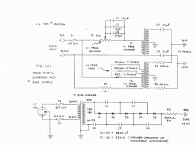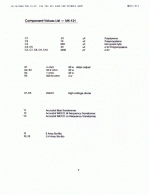Any ideas out there? I have a pair of Acoustat planar speakers that are probably 15-16 years old. I believe they must have been prototypes because they don't have any model number. A friend of mine worked for Rockford Fosgate in the early 90's and he was given them as a parting gift. I receieved them from his family after he died.
These are black panel speakers, about 6' in height and appx 2' wide with a power supply. They have remarkable sound quality. The other night the power supply fried. I took it apart and the board is fairly ruined with some pretty severe burning. There are two large 100k resisters and two capacitors generating 6000 volts. At this point I can't tell if a problem in the power supply caused the board to short out or if it was a problem with the board if the power supply is now damaged.
I'm wondering if anyone might know how I would go about getting the board replaced? I'm going to try to raise Acoustat UK on the phone but I thought I'd try here too.
Thanks in advance
Don M.
These are black panel speakers, about 6' in height and appx 2' wide with a power supply. They have remarkable sound quality. The other night the power supply fried. I took it apart and the board is fairly ruined with some pretty severe burning. There are two large 100k resisters and two capacitors generating 6000 volts. At this point I can't tell if a problem in the power supply caused the board to short out or if it was a problem with the board if the power supply is now damaged.
I'm wondering if anyone might know how I would go about getting the board replaced? I'm going to try to raise Acoustat UK on the phone but I thought I'd try here too.
Thanks in advance
Don M.
Hi,
Acoustat UK ? I don't think so. American firm, now China based.
You should rebuild both boards based on measurements etc from
the board that is still working, hopefully all transformers are still OK.
Use point to point wiring if its not too complicated and read
up a bit on high voltage building practise, can't do any harm.
🙂/sreten.
Acoustat UK ? I don't think so. American firm, now China based.
You should rebuild both boards based on measurements etc from
the board that is still working, hopefully all transformers are still OK.
Use point to point wiring if its not too complicated and read
up a bit on high voltage building practise, can't do any harm.
🙂/sreten.
Thanks for the tip on rebuilding the boards. I was fairly certain I'd have to makeover both of them. Has anyone heard of Andi Szadl. Apparently he is an expert on Acoustats and does the forum boards. If there is some contact info out there I'd love to have it.
Don
Don
Try here under Acoustat http://www.audiocircuit.com/index.php# . Andy Szabo is the name of the person that used to work at Acoustat
it's pretty simple.
The HV supply runs up the middle.
It is a multiplier circuit.
It boosts the original AC voltage up to 5kv.
The two other caps are caps, but high voltage.
They couple the HF part of the audio.
The resistors are probably fine.
They couple the "LF" part of the audio.
It is VERY unusual to burn up a board.
What happend when it burned up?
Were you playing it?
Is only the diode/cap multiplier burned up (the middle bit)
Usually what happens with them is that the caps short or get very leaky. Then they take out the diodes.
I just had the 500mohm on one channel open! Wierd.
That's probably the hardest part to replace there.
When you go to rebuild buy caps with 6kv ratings so you can forget about them forever. Replace both sides. They are .003ufd, but the value is NOT critical at all.
I have used a pair of 1000PIV 1amp diodes in series per leg with no breakdown problems so far, for replacements. Or you can buy HV diodes. Or steal big HV diodes from microwave ovens, or maybe find some in the HV supplies of junked copiers and laser printers too...
Hopefully the two audio coupling caps are just dirty, and not melted. If so, clean them in the sink with some Fantastik or similar strong spray cleaner and let them dry. Get all the black soot off, if there is any.
Remove the board, of course you already have if you cleaned the caps. Desolder the burnt stuff. Desolder the rest... make note of where it all went first. Clean the board on the non foil side with cleaner and abrasive: first cleaner, then if needed "Scotchbrite" scouring pad, if needed then steel wool, and if still needed sandpaper and/or an exacto knife - until there is no sign of the burn.
I presume these are green fiberglass boards, not brown phenolic boards. The phonolic won't clean up quite as well.
If the damage is really bad to the board, and you have gouged the board fairly well, don't worry. Even through holes are not a problem here.
Silicone Rubber is a very good HV insulator when dried, and there are assorted HV "dopes" to be had mailorder or from an electronics store, that can be used to fix up problem spots where possible arcing might occur from the fix - which is rather unlikley given the layout.
If there is black on the foil side, clean NOT on the foil by the same methods. Near the foil use things like an eraser, and an exacto knife.
The idea is eliminate the breakdown path(s) completely. 5kv likes to travel if it can.
Worst case, you can build a copy on perf board, it will work just fine.
The HV caps - were these yellow film caps or the older brown colored caps?? These are the hardest to replace, but not impossible.
IF you must replace them, BUY FOUR!! You want both channels to sound the same.
Any other questions, you can ping me...
_-_-bear
The HV supply runs up the middle.
It is a multiplier circuit.
It boosts the original AC voltage up to 5kv.
The two other caps are caps, but high voltage.
They couple the HF part of the audio.
The resistors are probably fine.
They couple the "LF" part of the audio.
It is VERY unusual to burn up a board.
What happend when it burned up?
Were you playing it?
Is only the diode/cap multiplier burned up (the middle bit)
Usually what happens with them is that the caps short or get very leaky. Then they take out the diodes.
I just had the 500mohm on one channel open! Wierd.
That's probably the hardest part to replace there.
When you go to rebuild buy caps with 6kv ratings so you can forget about them forever. Replace both sides. They are .003ufd, but the value is NOT critical at all.
I have used a pair of 1000PIV 1amp diodes in series per leg with no breakdown problems so far, for replacements. Or you can buy HV diodes. Or steal big HV diodes from microwave ovens, or maybe find some in the HV supplies of junked copiers and laser printers too...
Hopefully the two audio coupling caps are just dirty, and not melted. If so, clean them in the sink with some Fantastik or similar strong spray cleaner and let them dry. Get all the black soot off, if there is any.
Remove the board, of course you already have if you cleaned the caps. Desolder the burnt stuff. Desolder the rest... make note of where it all went first. Clean the board on the non foil side with cleaner and abrasive: first cleaner, then if needed "Scotchbrite" scouring pad, if needed then steel wool, and if still needed sandpaper and/or an exacto knife - until there is no sign of the burn.
I presume these are green fiberglass boards, not brown phenolic boards. The phonolic won't clean up quite as well.
If the damage is really bad to the board, and you have gouged the board fairly well, don't worry. Even through holes are not a problem here.
Silicone Rubber is a very good HV insulator when dried, and there are assorted HV "dopes" to be had mailorder or from an electronics store, that can be used to fix up problem spots where possible arcing might occur from the fix - which is rather unlikley given the layout.
If there is black on the foil side, clean NOT on the foil by the same methods. Near the foil use things like an eraser, and an exacto knife.
The idea is eliminate the breakdown path(s) completely. 5kv likes to travel if it can.
Worst case, you can build a copy on perf board, it will work just fine.
The HV caps - were these yellow film caps or the older brown colored caps?? These are the hardest to replace, but not impossible.
IF you must replace them, BUY FOUR!! You want both channels to sound the same.
Any other questions, you can ping me...
_-_-bear
Hi,
Is silicone rubber really a good insulator ? I remember i read that someone had serious leakage problems due to silicone rubber.At least standart silicone is leaky ( i have tested this by myself , had an idea to use it for conductive diapraghm coating 🙂.
Regards,
Lukas.
Is silicone rubber really a good insulator ? I remember i read that someone had serious leakage problems due to silicone rubber.At least standart silicone is leaky ( i have tested this by myself , had an idea to use it for conductive diapraghm coating 🙂.
Regards,
Lukas.
Hey Northpoint
Can you post a picture of the power supply as I may have a couple of them. I have a lot of the old parts (new and unused)
including transformers.
Martin
Can you post a picture of the power supply as I may have a couple of them. I have a lot of the old parts (new and unused)
including transformers.
Martin
Bazukaz said:Hi,
Is silicone rubber really a good insulator ? I remember i read that someone had serious leakage problems due to silicone rubber.At least standart silicone is leaky ( i have tested this by myself , had an idea to use it for conductive diapraghm coating 🙂.
Regards,
Lukas.
Yeah, pretty good insulator.
Dunno who had leakage due to what.
It is often used commercially to "pot" connections in commercial HV supplies. I just robbed a junker supply of a 100Mohm resistor that was gooped on both ends with silicone rubber.
You'll find it on the HV connections in monitors and TVs too.
Where you can get into trouble is with household Silicone Rubber, since it has acetic acid in it, which over time can corrode what it is nominally connected to. There are commercial Silicone Rubber products that do not have the acetic acid (for curing, I hear) in the formula at all.
As far as being "leaky" for diaphragms? Perhaps, but we are talking how many megohms per sq inch at what thickness? Also how many thousand volts per mil thickness??
_-_-bear
- Status
- Not open for further replies.
- Home
- Loudspeakers
- Planars & Exotics
- Acoustat Troubles - Need Advice

